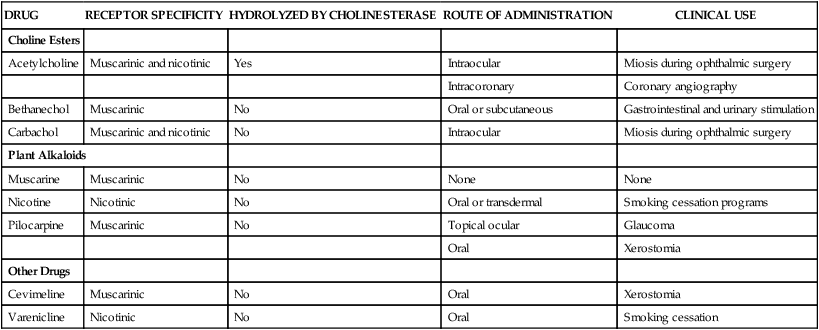Muscarinic receptors are divided into five subtypes, M1 through M5, based on their pharmacologic properties and molecular structures. The principal subtypes found in most tissues are M1, M2, and M3 receptors (Table 6-1). Muscarinic receptor stimulation leads to the activation of guanine nucleotide-binding proteins (G proteins), which increases or decreases the formation of other second messengers (see Chapter 3). The M1, M3, and M5 receptors are coupled with Gq proteins and their activation stimulates phospholipase C, leading to the formation of inositol triphosphate (IP3) and diacylglycerol from membrane phospholipids. In smooth muscles, IP3 increases calcium release from the sarcoplasmic reticulum and promotes muscle contraction. In exocrine glands, IP3 causes calcium release and glandular secretion. In vascular endothelial cells, IP3-activated calcium release stimulates nitric oxide synthesis, leading to vascular smooth muscle relaxation. TABLE 6-1 Properties of Acetylcholine Receptors The M2 and M4 receptors are coupled with Gαi proteins; their activation decreases cyclic adenosine monophosphate (cAMP) levels by inhibiting adenylate cyclase and also increases potassium efflux. The effects produced by activation of muscarinic receptors are summarized in Table 6-1. The acetylcholine receptor agonists that are currently available for clinical use do not selectively activate subtypes of muscarinic receptors, but an M1 selective antagonist, pirenzepine, has been developed (see Chapter 7). Nicotinic receptors are pentamers formed by the assembly of five transmembrane polypeptide subunits (Fig. 6-1). These subunits are divided into classes (alpha [α] through epsilon [ε]) according to their molecular structure. Each type of nicotinic receptor (muscle, ganglionic, brain) is composed of a unique combination of these subunits. All subunits appear to participate in the formation of acetylcholine-binding sites and influence the functional properties of the receptors, but a clear understanding of the unique roles of the different classes of subunits has not yet been obtained. The direct-acting agonists include the choline esters, the plant alkaloids, and synthetic drugs called cevimeline and varenicline. These drugs all bind and activate acetylcholine receptors, but they differ with respect to their affinity for muscarinic and nicotinic receptors and their susceptibility to hydrolysis by cholinesterase (Table 6-2). TABLE 6-2 Properties and Clinical Uses of Direct-Acting Acetylcholine Receptor Agonists Muscarinic receptor agonists increase lacrimal gland secretion and stimulate contraction of the iris sphincter muscle and the ciliary muscles. Contraction of the iris sphincter muscle produces pupillary constriction (miosis), whereas contraction of the ciliary muscles enables accommodation of the lens to focus on close objects (Fig. 6-2).
Acetylcholine Receptor Agonists
Overview of Cholinergic Pharmacology
Acetylcholine Receptors
Muscarinic Receptors
TYPE OF RECEPTOR
PRINCIPAL LOCATIONS
MECHANISM OF SIGNAL TRANSDUCTION
EFFECTS
Muscarinic
M1 (neural)
Autonomic ganglia, presynaptic nerve terminals, and CNS
Increased IP3
Modulation of neurotransmission
M2 (cardiac)
Cardiac tissue (sinoatrial and atrioventricular nodes)
Increased potassium efflux or decreased cAMP
Slowing of heart rate and conduction
M3 (glandular)
Smooth muscle and glands
Increased IP3
Contraction of smooth muscles and stimulation of glandular secretions
Vascular smooth muscle
Increased cGMP as a result of nitric oxide stimulation
Vasodilation
Nicotinic
Muscle type
Neuromuscular junctions
Increased sodium influx
Muscle contraction
Ganglionic type
Autonomic ganglia
Increased sodium influx
Neuronal excitation
CNS type
CNS
Increased sodium influx
Neuronal excitation

Nicotinic Receptors
Direct-Acting Acetylcholine Receptor Agonists
DRUG
RECEPTOR SPECIFICITY
HYDROLYZED BY CHOLINESTERASE
ROUTE OF ADMINISTRATION
CLINICAL USE
Choline Esters
Acetylcholine
Muscarinic and nicotinic
Yes
Intraocular
Miosis during ophthalmic surgery
Intracoronary
Coronary angiography
Bethanechol
Muscarinic
No
Oral or subcutaneous
Gastrointestinal and urinary stimulation
Carbachol
Muscarinic and nicotinic
No
Intraocular
Miosis during ophthalmic surgery
Plant Alkaloids
Muscarine
Muscarinic
No
None
None
Nicotine
Nicotinic
No
Oral or transdermal
Smoking cessation programs
Pilocarpine
Muscarinic
No
Topical ocular
Glaucoma
Oral
Xerostomia
Other Drugs
Cevimeline
Muscarinic
No
Oral
Xerostomia
Varenicline
Nicotinic
No
Oral
Smoking cessation

Choline Esters
General Properties
Ocular Effects
< div class='tao-gold-member'>
![]()
Stay updated, free articles. Join our Telegram channel

Full access? Get Clinical Tree


Acetylcholine Receptor Agonists
Only gold members can continue reading. Log In or Register to continue


